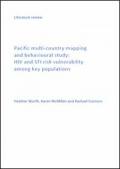Publications - Released in 2016
The Pacific Island countries and territories (PICTs) are a group of small island nations that are particularly diverse, with widely varying political regimes, cultural norms and languages. Most information on newly detected HIV cases in the Pacific has been obtained from routine HIV testing. Sexual transmission is established as the predominant mode of transmission (95%), with varying shares of heterosexual versus male-to-male transmission between sub-regions (for example, Micronesia, Melanesia, Polynesia) and countries within sub-regions.
This review will describe the extant literature on key populations vulnerable to HIV in order to inform a mapping and behavioural study that will provide a baseline for the implementation of the Integrated HIV/TB multi-country grant in the Pacific and for the Pacific Regional Sexual and Reproductive Health Programme, by providing quantitative and qualitative data to inform relevant interventions aiming at reducing the HIV and STI risk vulnerability of key populations, as well as consolidating and generating specific evidence to evaluate barriers to prevention, improve effectiveness of prevention interventions, and develop a strong advocacy case for legal and social transformation. In many Pacific countries, there is a dearth (or even a complete lack) of data about each of the key populations.






